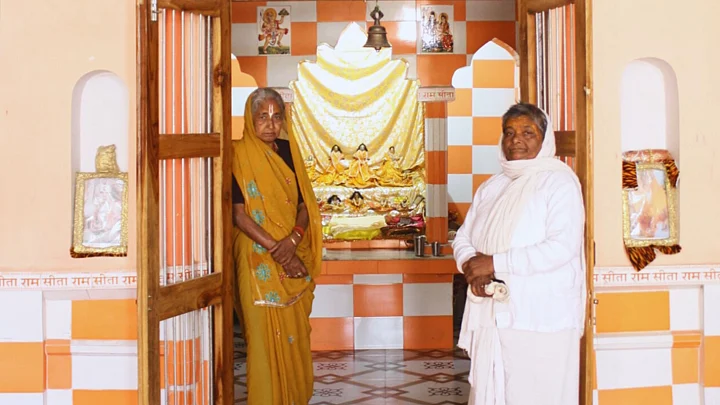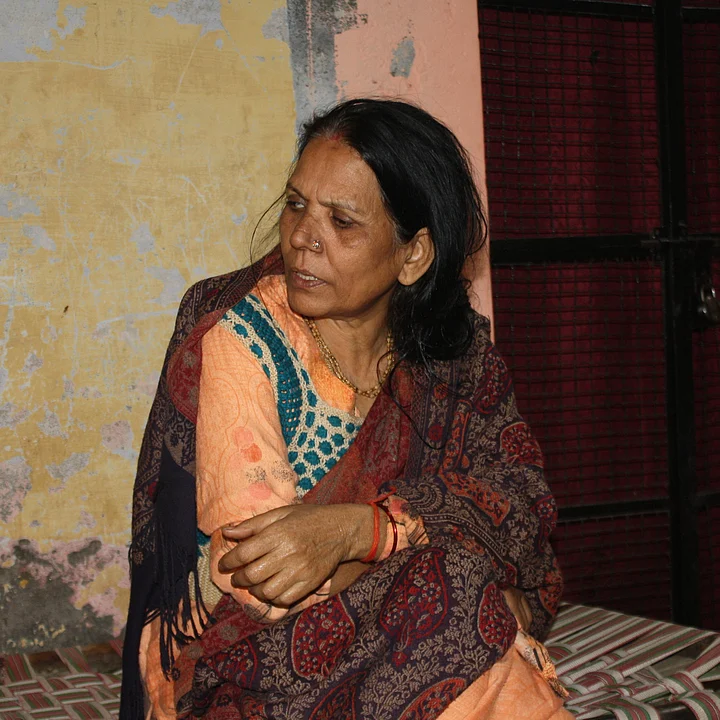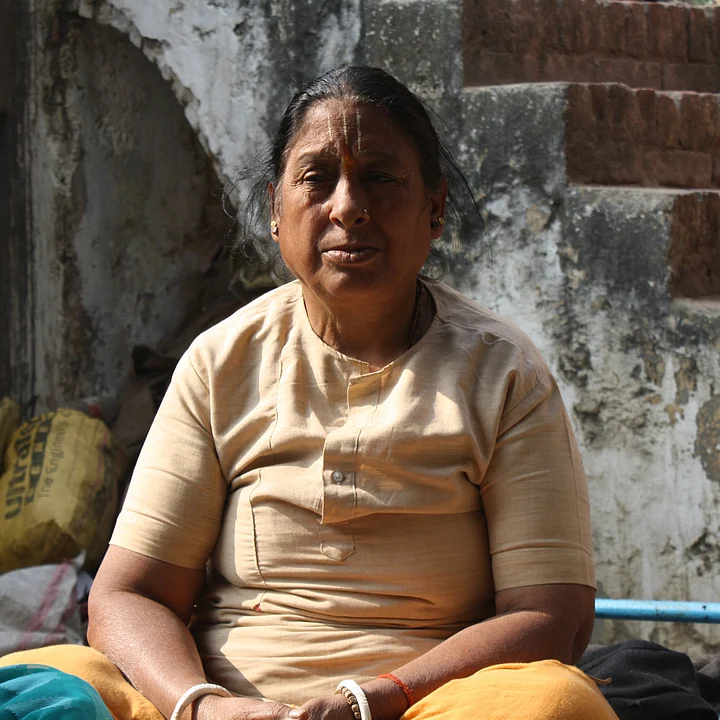Draped in a soft white cotton dhoti and kurta, with short hair and chandan tilak smeared on the forehead, Krishna Dasi, 74, could be easily mistaken for a male Vaishnav sadhu, commonly sighted in the temple town of Ayodhya in Uttar Pradesh (UP). Except, she is the head priestess of the Mai Bada, a unique temple of lord Ram and the goddess Sita, exclusively maintained by women mahants and caretakers.
Women mahants or priestesses are rare but not uncommon in Ayodhya, even if their presence goes unnoticed in the largely male-dominated seer community.
“Everyone in Ayodhya knows about us. We belong to the Ramanandi Sampradaya of the sadhu samaj who have given us the title of mahant,” said Krishna Dasi, a third-generation head priestess in charge of the temple since 2017.
On 22 January, when Prime Minister Narendra Modi will inaugurate the Ram Mandir, 4500 sadhus, seers, and priests have been invited to the consecration ceremony from diverse sections, including Dalits and tribal leaders across the country. Krishna Dasi and her peers from the Mai Bada, however, will be absent from the celebrations.
“We are rarely invited to any political events which include big ministers and politicians… only important male sadhus, mahants are called,” Krishna Dasi said. Even government benefits in the form of funds, subsidies, and grants go to temples headed by male seers, she added, pointing out the low status of impoverished temples like the Mai Bada.
Mai Bada — Where No Male Priest is Allowed to Do Puja
Tucked away in a narrow alley, less than a mile away from the Ram Janmabhoomi Mandir, the Mai Bada, established nearly 150 years ago, has been traditionally maintained by priestesses. The temple’s name means a courtyard for mothers and it also functions as an abode for widows, orphans, destitute, and abandoned women devotees.
“We women conduct all the functions of the temple. We act in the service of Ram ji and Sita ji, and mothers (female devotees) who live here,” Krishna Dasi, said. She left her home in Rewa, Madhya Pradesh, and became a vairagi (renunciate) in 1982.
The Mai Bada has three temples, each headed by a priestess that also functions as a shelter for around 45 priestesses and caretakers. The place has turned into a safe community for women, some of whom live exclusively a hermit life, while others use its accommodation to study and earn money on the side.
The youngest occupant is a 15-year-old girl adopted by the previous mahant, Reshma Dasi, and the oldest is Ram Snehi Dasi, around 90 years old. The shelter offers two free meals and a room to live in.
“Poverty was rampant around here and girls who would run away from family or were abandoned by their husbands would readily find a home here,” recalled Janaki Das, another mahant. “In the Mai Bada, they would get meals and spirituality. Yaha par ek time bhojan, ek time bhajan ki vyavastha thi.”
The three temples have been, so far, functioning independently, and have resisted attempts to register as a trust, due to fear of losing the land. They collect alms from devotees and receive enough donations from dedicated patrons to buy monthly rations and pay bills.
Mai Bada came to be established in the late 18th century when devoted female seers or sanyasis had no place of their own. “They would pitch a machan (tent) along the banks of the Saryu River and reside there. Later, women seers brought a piece of land and built this temple here,” Krishna Dasi said.
Another legend states that female companions accompanying Sita when she first came to Ayodhya, stayed back in a place that came to be known as Janaki Baug and later turned into Mai Bada. The place has since been a safe haven for destitute and women devotees from neighboring villages and towns, who seek support to live a life of a renunciate.
Nearly all the temples are headed by male seers, and as per the Vaishnav traditions, female seers are prohibited from residing on the same premises.
Ganga Dasi, 72, who came to Ayodhya from Ragarganj village in Gonda district of UP five years ago, was told to head to Mai Bada. “I left my family because I wanted to devote myself to bhakti. I am a Ram devotee and I stay here and conduct the temple’s puja,” she said.
As per the traditions of the Ramanandi sect, according to which the majority of temples in Ayodhya function, male celibate priests (vairagis) can worship Ram’s idol but are prohibited from worshipping Rama and Sita together. They are prohibited from engaging in daily rituals like bathing and clothing Sita’s idol. These rituals are conducted by the seers from the Sakhi sect (male priests who follow the mannerisms of women and are known as female companions of Sita).
“No male priest is allowed to conduct puja here,” she said.
'Times are Changing'
The mahants and priestesses of Mai Bada’s temples follow the same routine as other male seers — bathe at the crack of dawn, followed by meditation, puja, a morning hawan, and bhog prasad. The evenings are spent singing kirtans and bhajans with all the female devotees.
- 01/02
Mahant Janaki Dasi.
(Photo: Author)
- 02/02
Mahant Lalita Dasi.
(Photo: Author)
Dr Mamta Shastri stated that one of the reasons that Mai Bada’s mahants do not command the same reputation as other seers is because of the temple’s special character as a shelter for the destitute. In 2015, Shashtri became the first female mahant in Ayodhya to take charge of the ancient Darshan Bhavan temple at Ganga Ghat temple. She credits her revolutionary guruji Vishwanath Das Shastri, former BJP MP, who treated men and women disciples equally, for nominating her.
She contended that the seer community in Ayodhya has been conservative in the past and was not reformed enough to readily accept female seers. “It's not like there have been no learned women or religious scholars, but not many male seers wanted to support them. God doesn’t discriminate between male or female priests but our society does,” she said.
Shastri, who has a degree in religious shastras and a PhD in Psychology, faced opposition and salacious comments from the seer community who condemned her appointment as a downfall of the temple’s legacy. “Within 6 months I won their trust and established my reputation as a learned priest with detailed knowledge about the rituals and ceremonies,” she said.
Unlike the Mai Bada priests, Shastri, who has a close affinity with Sangh Parivar and the BJP, has been invited to the inaugural ceremony. Another mahant, Sunita Shastri, will also attend the ceremony.
Dr Shastri said that Ayodhya’s religious landscape was changing and more women were gaining prominence as reciters of Ram Katha, kirtankars, and priestesses. She hoped these changes would also make space for priestesses in the new Ram Mandir. “Times are changing. Maybe in the future, we will have women doing puja of Ram Lalla.”
(Shweta Desai is an independent journalist and researcher from Mumbai.)
(At The Quint, we question everything. Play an active role in shaping our journalism by becoming a member today.)


